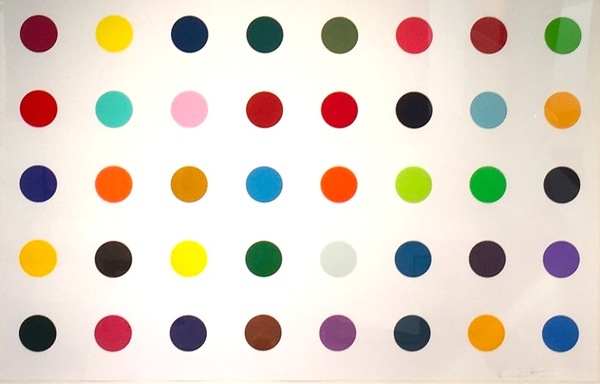Tag Archives: spots
Damien Hirst rejoins Gagosian
Click here or on the picture to read the full article
WOW! – Work of the Week 7/13/15
Damien Hirst, Methylamine-13c
Damien Hirst
Methylamine-13c
2014
Screenprint with glaze and diamond dust
33 1/16 x 27 in.
Edition of 100
This piece is signed and numbered in pencil on verso.
About This Work:
Hirst’s spot paintings and prints are amongst his most widely recognized works, with the ‘Pharmaceutical’ paintings first and most prolific of the 13 spots sub-series.
His work with spots, specifically when named after synthetic and natural compounds in drugs and pharmaceuticals, explores themes fundamental to the his work. Namely the complex relationships between nature and science, myth and reality, art and beauty, and life and death.
No one color spot is the same color as another. The colors he uses in conjunction with drug and pharmaceutical titles suggests they represent different emotions/states e.g. red means love, white means purity, black means death, blue means the blues, green means jealousy. Alluding to that fact, that all human emotions or sensations or natural science can be expressed, aesthetically, in the spots.
About Damien Hirst:
Damien Hirst has become one of the most prominent artists of his generation. Many of his works are widely recognized, from the shark suspended in formaldehyde, “The Physical Impossibility of Death in the Mind of Someone Living”, and his spot, spin and butterfly paintings, through to later works such as the diamond skull “For the Love of God”.
Throughout his work, Hirst investigates and challenges contemporary belief systems, and dissects the tensions and uncertainties at the heart of human experience. Hirst takes a direct approach to ideas about existence, exploring the complex relationship between art, life, death and religion. His work calls into question our awareness and convictions about the boundaries that separate desire and fear, reason and faith, love and hate.
By using the tools and iconography of science and religion, he blurs the lines between science, religion, and art, giving the viewer the horror of immortality and the brilliance of reality.
Death is a central theme in Hirst’s art work. He gives his audience an open mouth astonishment while challenging the viewer to confront the inevitability of existence. He became famous for a series of artworks in which dead animals (including a shark, a sheep and a cow) are preserved—sometimes having been dissected—in formaldehyde. The best known of these being The Physical Impossibility of Death in the Mind of Someone Living, a 14-foot tiger shark immersed in formaldehyde in a vitrine.
In September 2008, he took an unprecedented move for a living artist by selling a complete show, Beautiful Inside My Head Forever, at Sotheby’s by auction and by-passing his long-standing galleries. The auction exceeded all predictions, raising $198 million, breaking the record for a one-artist auction.
Since 1987, over 80 solo shows of Damien Hirst exhibitions have taken place worldwide, and his work has been included in over 260 group shows. His contributions to art over the last two and a half decades was recognized in 2012 with a major retrospective of his work at the Tate Modern.



